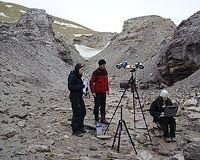 |
Houston TX (SPX) Oct 22, 2009 NASA has chosen 18 proposals from universities around the country to receive up to $70,000 for Phase One of the NASA Ralph Steckler Space Grant Colonization Research and Technology Development Opportunity. Grant money will support university research and technology development activities that support a sustained human presence in space, increase understanding of the moon's environment and develop basic infrastructure for future space colonies. "I'm excited that many of the awards will provide a dual benefit to exploration and to Earth conservation by focusing on important issues such as water recycling, food production and power storage," said Frank Prochaska, manager of the Steckler Space Grant Project at NASA's Johnson Space Center in Houston. NASA selected two proposals from Cornell University in Ithaca, N.Y., and the University of Arizona in Tucson and one proposal from each of the following academic institutions: Desert Research Institute in Reno Massachusetts Institute of Technology in Cambridge Montana State University in Bozeman New Mexico State University in Las Cruces Ohio Aerospace Institute in Cleveland Old Dominion University Research Foundation in Norfolk, Va. Pennsylvania State University in University Park Texas Tech University System in Lubbock University of California in San Diego University of Central Florida in Orlando University of Hartford in West Hartford, Conn. University of Idaho in Moscow University of North Texas in Denton University of Wisconsin in Green Bay The projects selected to receive Steckler Space Grants will be implemented through three funding and development phases. Phase One will last nine months with a maximum award up to $70,000. The purpose of Phase One is to establish the scientific and technical merit and feasibility of a proposed innovation, research, or technology development effort that could enable space colonization or settlement. Primary exploration elements include habitation, rovers, surface power, communications and extravehicular activity systems. Phase Two, which lasts two years, will provide a maximum of $250,000 each to four of the most promising Phase One projects through a competitive selection based on scientific and technical merit. The purpose of Phase Two is to begin conducting the research and technology development effort. Two awards of up to $275,000 each will be given for the third phase, also two years, during which time the Phase Two efforts will be integrated with NASA programs or projects. NASA received 35 proposals. The agency released the cooperative agreement notice inviting lead institutions of the National Space Grant College and Fellowship Program to submit proposals for these grants in November 2008. The Space Grant national network includes more than 850 affiliates from universities, colleges, industry, museums, science centers, and state and local agencies supporting and enhancing science and engineering education, research and public outreach efforts for NASA's aeronautics and space projects. These affiliates belong to one of 52 consortia in all 50 states, the District of Columbia and the Commonwealth of Puerto Rico. Ralph Steckler was an assistant film director and photographer from southern California who had a lifelong interest in space colonization. He left part of his estate to NASA for the colonization of space and the betterment of mankind. Those funds are now providing universities with NASA research opportunities based on his vision. With this program and NASA's other college and university programs, the agency continues its tradition of investing in the nation's education programs with the goal of developing science, technology, engineering and math skills and capabilities critical to achieving the nations' exploration goals. Share This Article With Planet Earth
Related Links NASA education programs Space Tourism, Space Transport and Space Exploration News
 Building An Astrobiology Tool Kit
Building An Astrobiology Tool KitMoffett Field CA (SPX) Oct 21, 2009 How can we be sure that instruments that will be sent on future Martian missions will work properly? How do we know that they will obtain accurate and precise measurements? How will we be able to compare the data to what we have seen on our planet? The answer is easy: by testing, testing and again testing them during field trips on Earth. This has been one of the most important goals of ... read more |
|
| The content herein, unless otherwise known to be public domain, are Copyright 1995-2009 - SpaceDaily. AFP and UPI Wire Stories are copyright Agence France-Presse and United Press International. ESA Portal Reports are copyright European Space Agency. All NASA sourced material is public domain. Additional copyrights may apply in whole or part to other bona fide parties. Advertising does not imply endorsement,agreement or approval of any opinions, statements or information provided by SpaceDaily on any Web page published or hosted by SpaceDaily. Privacy Statement |